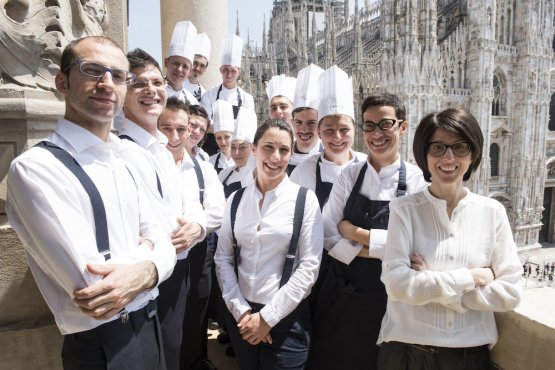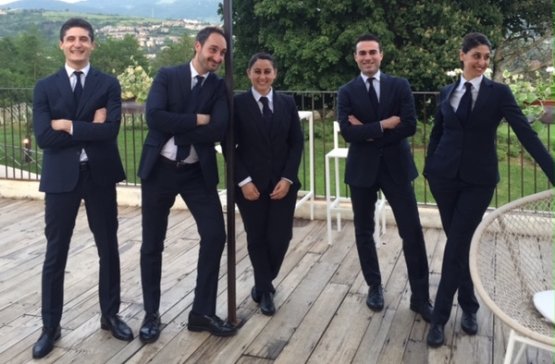Cristiana Romito, Niko’s sister, is the maître at restaurant Reale in Castel di Sangro (L’Aquila) and coordinates the hospitality at Casadonna, the ex convent incorporating restaurant, hotel and school. Beside her in the team for 12 years there’s been Gianni Sinesi, and with them a close-knit and young team which today includes Ileana D’Ercole, Matteo Albanesi, Simone Angeletti and Yamila Cristofalo.
Fabio Catino and Francesco Spina have also worked at Reale. Having joined the Casadonna project and therefore the birth of Spazio, the restaurant cum training-lab for Niko Romito Formazione, they set and fully coordinate the dining room at Spazio Milano (Catino as director/manager and Spina as his right arm).
The person shaping and directing the dining room at Spazio Roma is instead Sabrina Romito, Cristiana’s twin sister. Self-trained, just like her siblings, from whom she absorbed the foundations of the profession, today’s she’s fully part of the “group”. What’s similar and what differs in the hospitality offered at Reale and Spazio? Cristiana and Gianni share their thoughts in turn.

Sabrina Romito (Cristiana’s twin sister, the first to the right, next to Gaia Giordano), Fabio Catino and Francesco Spina (the first two to the right) with the team at Spazio Milano, on the terrace facing the Duomo. Niko Romito’s galaxy also includes two more Spazio restaurants: in Rivisondoli in Abruzzo and inside Eataly Roma (photo by Brambilla/Serrani)
: As a child, I would have never thought of taking on this career. I dreamt of being a hostess, or even working in the European Parliament: perhaps I was already attracted by the idea of meeting people from different countries and backgrounds. I attended high school and university in Rome, because that’s what my father wanted for us children. I took piano classes and graduated in foreign languages. When dad passed away
Niko dropped out of Economics and returned to Rivisondoli to run
Reale, which at the time was a simple
trattoria. I followed him shortly afterwards. I was shy and didn’t drink. I trained as a sommelier and visited as many restaurants as I could, observing: I always say that I learnt my trade “as a client”.
Gianni Sinesi: At 10 I would serve bread and water at the family restaurant, in Barletta. At 14 I told myself: «I either attend the college of music or catering school»; in the end I chose the school in Roccaraso, one of the best at the time. It was an important step yet the most important experience, which I recommend to all, is the summer season in Riccione, 4 months without break: that’s where I learnt speed and precision. Then I met Niko and Cristiana: I knew nothing of the Michelin system and little of cellars. One night at Reale a client asked me if we had an oaked wine and I didn’t know what to say: Niko waved his arms from the kitchen giving me the answer! I studied and also thanks to an internship with Maurizio Menichetti at restaurant Da Caino I started to understand wine.

Another picture with the team at Castel di Sangro. Left to right, Angeletti, Sinesi, Yamila Cristofalo, Albanesi and D'Ercole
: The process was gradual yet unstoppable, with sacrifices and the desire to keep on raising the standards. The dining room at
Reale has a formal yet modern approach, there are neither stiffness nor servility; it’s the way we like it, but we don’t let down our guard: it would be a great mistake to consider us accomplished.
G.S.: The dining room is hierarchical, yet everyone must know everything. It’s essential so as to distribute roles, like in a football team. Every dining room has its rules. And you need to break them, if needed. But first you must know them, start from the basics: cleanliness, yours and that of the work space, service technique. And then you have the additional experience which can improve the performance: a nice NLP [neuro-linguistic programming] course, for instance, can be useful.
C.R.: Dining rooms are a place for interaction, for stories: in fine dining dishes need to be explained most of the time, and guests often ask questions about the food and not only on that.
1. to be continued